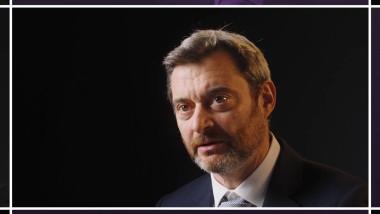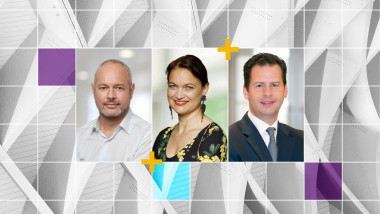Manager Point of View: Schrödinger’s CAPE?
The CAPE is not telling you when something is going to happen. Rather, it suggests that something in the market is changing."
 Carmine De Franco
Carmine De Franco Carmine De Franco, Head of Fundamental Research at Ossiam, doesn’t think so and explains why he believes CAPE is still very much alive but cautions that using it as a predictor of market inflection points is to overlook its real power as an investment tool.
In a world of low rates, yield-thirsty investors have clearly looked at risky assets, for their asset allocation, pushing equity prices up – perhaps a little too high, given the current economic outlook.
What’s more concerning is the responsiveness of valuations compared to earnings growth. Using lower interest rates in a discounting model will automatically produce higher valuations, as lower rates means lower interest expenses and higher profits.
Low rates and high valuations are not actually the issue – but if companies are reducing their earnings estimates, while market participants push valuations even higher, it could be cause for concern. What’s more, this could lead to the issuance of debt to buy back equity.
On the point about comparing interest rates at two different periods of time, the main difficulty is that, because CAPE is a very long term metric choosing the appropriate interest rates to make the comparison will be complicated. For instance, do you use the interest rates today or the interest rate 10 years ago – or the average?
Choosing the right one could be very subjective, so we prefer to say that, in the case of long-term metrics, what really matters is how the market is actually pricing the earning power of companies.
The answer today, very simply, is that the market is pricing the earning power of US companies higher on average than it used to be, from a long-term perspective.
Professor Shiller made a substantial review of the CAPE by stress-testing all of Siegel’s points². For example, he recalculated CAPE today with readjusted data. And what he found was that, over the long run, it doesn't really matter. If the CAPE is at 30, it’s expensive compared to the average. Whereas if you lower the average and you lower the level today, it doesn't change the meaning.
Clearly, technical issues can change the value of CAPE over the short term. But the main reason why CAPE is significantly higher today than in the past is predominantly an earnings story.
It’s the same with the CAPE ratio. The key point here is that with all of these indicators, they are not telling you when something is going to happen. Rather, they suggest that something in the market is changing.
We know that CAPE is not the perfect timing indicator that tells you when to exit from the stock market. But it does tell you that, today, the stock market is relatively expensive. And if you invest, you will not have the buffer needed to cover an eventual drawdown, because you are overpaying.
However, using the CAPE to identify relatively undervalued assets could bring insights and is another indicator in your toolkit. And if you look at some of the strategies based on CAPE, you see that performance of the sample since 2012 is outstanding. It beats the S&P500 on a regular basis – and it has not been easy to beat the S&P500 over the last few years. So all the evidence suggests that the CAPE is still a valid instrument of performance.
Earnings growth in the last ten years has dramatically outpaced GDP, while over the long run these growth rates tend to converge. Therefore, it seems that market prices have responded perhaps too optimistically to this earnings growth – due to, among other things, clearly depressed earnings exiting the global financial crisis and the recent sizeable fiscal boost – while US GDP has only slowly recovered, with a lower-than-expected pace.
High CAPE values in this phase might not trigger a severe correction, although this cannot be ruled out. But the point is that these valuations can be sustained only if US equities are able to continue to deliver such impressive earnings growth. Because we expect them to converge to GDP growth, we should pay attention to earnings contraction. In such case, stock prices may react faster than expected on the downside.
From this perspective, I think CAPE is telling investors not to overpay for earnings now, because we are already in the high values zone. Negative or lower earnings will definitely hurt your performance.
Obviously, these are averages. So when the CAPE is at 15, which is the long-term average, 1/15 is a roughly 6% – so this is more or less the premium on equity investments. When the CAPE is at 30 or 40, you are overpaying.
Now, I'm not saying that the next ten years will yield 3%, but likewise, it’s not unreasonable to suggest that you are entering the market at the very high point. So unless something happens that pushes the companies even higher, you are overpaying.
Furthermore, it’s worth considering that current trade tensions and geopolitical issues could slow the investment cycle of companies and disrupt global value chains. All of which puts pressure on earnings and then on prices, perhaps with more strength than if CAPE would be around their long term average 15.
Many sovereign bonds across the developed world are yielding negative, becoming quite expensive as well. With such valuations, perhaps investors assume that CAPE valuations should follow suit. Absolute levels therefore do not tell you the full story.
What’s important is the trend and how you compare it in a relative way. When you compare sectors, for example you better look at them relatively to their trend. It is clear then that looking at relative measures is valuable because they tell you a story of what's going on in the market and how the asset class is moving.
In our case, when we look at the CAPE for different sectors, we try to understand whether a particular sector is undervalued compared to its own expensiveness.
So it clearly adds value when you can see things in perspective and from a relative basis. Short-term changes will not change the overall picture, as CAPE will smooth out over the business cycle - it's a long term picture Valuation done with CAPE can yield interesting results that are somewhat different from the consensus. For example, value managers usually tend to see the tech sector as a whole as very expensive. However, relatively speaking, the sector is still undervalued compared to what it could be – based on potential earnings and historical trend. Taking the full business cycle into account will tell you if the market is correctly pricing the changes in earnings compared to the long-term average. And that, in essence, is the real value of the CAPE.
2 Shiller, R. and Jivraj, F. (2017). “The Many Colours of CAPE®”. Barclays QIS Insights [13th October 2017]






 Why Everyone’s Talking About… Democratising Private Assets
Why Everyone’s Talking About… Democratising Private Assets
 Views from the Collective: Are Individual Investors Ready for Private Assets?
Views from the Collective: Are Individual Investors Ready for Private Assets?